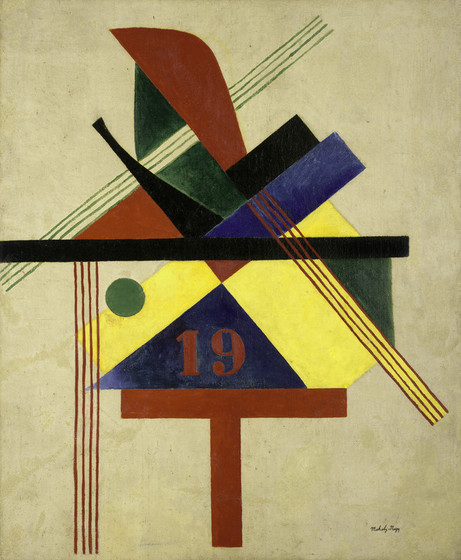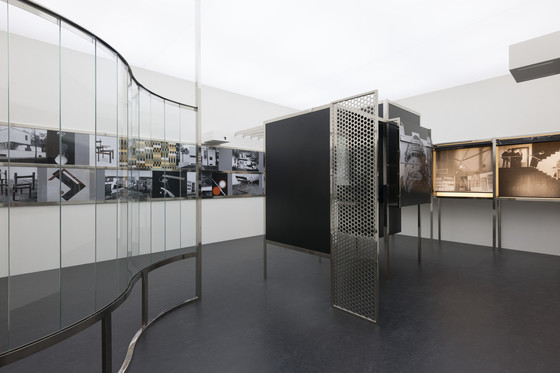8 minutes reading time
(1607 words)
Moholy-Nagy at LACMA

Art Review
BEYOND THE 805
Moholy-Nagy at LACMA
Every so often a person is able to see the consequences of their current time so clearly, to see the lines of development play out ahead of them, it is as if they can see the future. In such a case it doesn’t seem so much as if they influence those who come after, so much as that they seem to almost live and work in the future. Laszlo Moholy-Nagy was such an artist. Working well over a half-century ago, there are few areas of our visual culture today that have not been touched or anticipated in some way by Moholy-Nagy. God knows what might have happened had he lived long enough to use a computer.

László Moholy-Nagy, Room of the Present, Constructed 2009 from plans and other documentation, dated 1930,
Mixed media, inner dimensions: 137 3/4 x 218 7/8 x 318 3/4 in.,Van Abbemuseum, Eindhoven, 2953, © 2017 Hattula Moholy-Nagy/Artists Rights Society (ARS),
New York/VG Bild-Kunst, Bonn, photography by Peter Cox, Eindhoven, The Netherlands
Art Review
Moholy-Nagy at LACMA
Moholy-Nagy at LACMA
The current Los Angeles County Museum of Art [LACMA] retrospective exhibition of Laszlo Moholy-Nagy [1895-1946], Moholy-Nagy: Future Present, provides a rarely seen sense of the extent of Moholy-Nagy’s work and is the first show of this scale in the United States in almost 50 years. A Hungarian who taught at the famous Bauhaus school of art and design in pre-war Germany, Moholy-Nagy is probably the least known most influential artist of the last two or three centuries.
LACMA gives us a fairly sequential tour of Moholy-Nagy’s extensive journey through an astounding range of media including painting, graphic design, printing, photography, industrial design, film, sculpture--indeed virtually every field of design in the last century was touched and influenced by Moholy-Hagy. He was also a prolific writer and dedicated teacher.
The show starts with his rarely exhibited early paintings, heavily influenced by Malevic’s Suprematism, El Lissitzky, and the Constructivists. Like Malevic, Moholy-Nagy sticks to a highly limited palette, virtually monochromatic with the exception of the frequent use of bright red accents, and uses the hard-edge, rectilinear shapes similar to, but often in an even more constrained manner than El Lissitzky and Malevic.
Early on, Moholy-Nagy does not make a hard distinction between the fine art of, say, painting, and the practical application of visual design ideas. Through both publications and praxis, he makes clear that he feels a thorough visual re-think needs to be done across a much broader range of things than just fine art. It is this attitude and the rigorous design sensibility he displays for everything he does that attracts Moholy-Nagy to Walter Gropius, founder of the original Bauhaus school of Architecture and Design in Germany.
The Bauhaus provided a particularly strong fit for Moholy-Nagy’s approach to things. The Gropius program and philosophy that sought to re-design everything in modern life, from furniture to typography to architecture, fueled Moholy-Nagy’s natural instincts and talents. Ostensibly an architecture school, the Bauhaus had particularly strong painters and designers on its faculty recruited by Gropius, who sought the sharpest intellect and strongest talents he could find, regardless of their specialty or whether they considered themselves a fine or applied artist. As long as they had a strong sense of abstract design and a willingness to apply it and teach, Gropius was interested. The Bauhaus also encouraged experimentation with new materials and technologies and techniques appropriate to an industrialized age. Moholy-Nagy fit the bill on all counts.
The LACMA exhibition gives us prime examples of Moholy-Nagy’s output in all the media he tried while at the Bauhaus. There are publications featuring covers he designed and posters showing his interest in severely geometric layouts. Moholy-Nagy was noted for his preference for using diagonals to activate the two-dimensional surface. There are photograms, a technique that influenced the American, Man Ray, and there are designs, constructions, and sculptures.
Moholy-Nagy is heavily influenced by the Constructivists who were some of the first artists to work with plastics and the combination of machined parts to construct three-dimensional forms. The LACMA show gives us some superb examples of his plexiglass and steel constructions which were designed not for what the construction itself looked like, but for the shadows and light effects they produced when lights were directed toward them in a variety of ways, thus taking things a good step further than the Constructivists.
Like the Constructivists, Moholy-Nagy tended to prefer materials to look like their unadorned state, without further surface treatment or coloring; so stainless steel looks like stainless steel, plexiglass remains in its semi-clear state and publications exploit the qualities of their paper and areas of uncolored paper appear in his graphic designs. This gives a very “industrial” look to a lot of Moholy-Nagy’s finished work.

László Moholy-Nagy, 19, 1921, oil on canvas, 44 × 36 1/2 in., Harvard Art Museums/Busch-Reisinger Museum,
Gift of Sibyl Moholy-Nagy, BR53.44, © 2017 Hattula Moholy-Nagy/Artists Rights Society (ARS),
New York/VG Bild-Kunst, Bonn, photo © President and Fellows of Harvard College
The LACMA exhibit features the most famous of such constructions, Lichtrequisit einer elektrischen Bühne,or Light Prop for an Electric Stage [later, after his death, renamed the “Light-Space Modulator”] constructed in 1930 with Hungarian architect Istvan Seboek for the Deutscher Werkbund exhibition in Paris during the summer of 1930. The machine is now considered a pioneering effort in kinetic sculpture, but was originally intended to throw light designs and shadows onto a stage or room, that is, to make light “sculpture”, while now it is considered a sculpture in and of itself as well. This makes Moholy-Nagy one of the first to use motors and timing devices to produce kinetic art.
Moholy-Nagy’s interest and exploration of modern, machined materials, opened the way for him to take over Johannes Itten’s role in the legendary Preliminary Course at the Bauhaus in 1923, teaching it along with Josef Albers. He also replaced Itten as head of the metal workshop. Itten also taught the course in color and insisted in a wider application of color and color theory in one’s design approach. Historians of the Bauhaus have made much of the existence of two camps at the Bauhaus: one, a so-called Expressionistic camp featuring Itten, Paul Klee, Kandinsky, Josef Albers and those faculty and students with a more painterly bent which emphasized a formal study of color as a core part of its foundational study and praxis along with allowance for hand-made shapes and adornment, and the so-called “hard-edge” camp led by Moholy-Nagy which put a higher value on using materials in their naturally machined state and the avoidance of surface coatings, color, and any adornment coupled with straight lines or mechanically produced shapes and new technologies. This latter approach obviously influenced the architectural students at the Bauhaus such as Marcel Breuer and Mies van der Rohe.
Moholy-Nagy was also one of the first artists to use large, wall-sized transparent graphic images constructed for back-lighting, thus essentially inventing modern trade-show exhibition design, which hasn’t really moved that far from the limits and possibilities explored decades ago by Moholy-Nagy. With his interest in the total presentation context and the fusing of technology with art, Moholy-Nagy also opened up tremendous possibilities for new forms of art, such as the development of installation art, assemblage, the incorporation of almost any manufactured material into a work of art, and the current practice of using back-lit images and commercial presentation techniques in fine art museum and art fair exhibition design.
After the heady Bauhaus years, Moholy-Nagy was forced to leave Germany due to the Nazi situation and eventually came to Chicago after a series of failed attempts to set up a new design school or Bauhaus-like institute in London and work in the Netherlands.
The LACMA show gives us good examples of both his fine art from this time, primarily painting and photography, as well as his later design work. In Chicago, Moholy-Nagy essentially installs a new Bauhaus along the lines of the more Constructivist principles he promoted in an institute that eventually became the Illinois Institute of Technology, while Gropius founded another Bauhaus-like program along the more painterly lines at Black Mountain College. Albers brought similar principles and his famous course on color to Yale, while another Bauhaus graduate, the great Marcel Breuer eventually brought Bauhaus principles to the Harvard Graduate School of Design where he produced a long line of outstanding students including I. M. Pei, and his architecture and furniture design practice in New York City. Other Bauhaus-influenced designers exerted considerable influence at MIT and a host of State University art, architecture, and design programs. This helps fuel and inform the tremendous post-war explosion in American art and provides an unprecedented upgrade in the quality of training for American artists.
All these lines of influence were influenced by Moholy-Nagy. His impact on American art schools and design has been tremendous; yet very few Americans, even amongst today’s art school graduates, know who he is. This LACMA show will go a long way toward correcting that, and, since his ideas have had considerable influence in Los Angeles, especially in the realms of installation art, assemblage of any kind, abstraction and hard-edge painting, it will be good for people to see and experience the source of many of the ideas and innovations that still exert a force today.
_________________________________________________
Moholy-Nagy: Future Present
At the Los Angeles County Museum of Art [LACMA]
Organized by the Los Angeles County Museum of Art, the Solomon R. Guggenheim Foundation, and the Art Institute of Chicago
Through 18 June 2017
At the Los Angeles County Museum of Art [LACMA]
Organized by the Los Angeles County Museum of Art, the Solomon R. Guggenheim Foundation, and the Art Institute of Chicago
Through 18 June 2017
________________________________________
Comments
No comments made yet. Be the first to submit a comment
